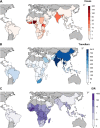Risk factors for UK Plasmodium falciparum cases
- PMID: 25091803
- PMCID: PMC4132200
- DOI: 10.1186/1475-2875-13-298
Risk factors for UK Plasmodium falciparum cases
Abstract
Background: An increasing proportion of malaria cases diagnosed in UK residents with a history of travel to malaria endemic areas are due to Plasmodium falciparum.
Methods: In order to identify travellers at most risk of acquiring malaria a proportional hazards model was used to estimate the risk of acquiring malaria stratified by purpose of travel and age whilst adjusting for entomological inoculation rate (EIR) and duration of stay in endemic countries.
Results: Travellers visiting friends and relatives and business travellers were found to have significantly higher hazard of acquiring malaria (adjusted hazard ratio (HR) relative to that of holiday makers 7.4, 95% CI 6.4-8.5, p < 0. 0001 and HR 3.4, 95% CI 2.9-3.8, p < 0. 0001, respectively). All age-groups were at lower risk than children aged 0-15 years.
Conclusions: These estimates of the increased risk for business travellers and those visiting friends and relatives should be used to inform programmes to improve awareness of the risks of malaria when travelling.
Figures


Similar articles
-
Risk factors for mortality from imported falciparum malaria in the United Kingdom over 20 years: an observational study.BMJ. 2012 Mar 27;344:e2116. doi: 10.1136/bmj.e2116. BMJ. 2012. PMID: 22454091 Free PMC article.
-
Descriptive analysis of malaria prophylaxis for travellers from Greece visiting malaria-endemic countries.Travel Med Infect Dis. 2011 Nov;9(6):284-8. doi: 10.1016/j.tmaid.2011.09.005. Travel Med Infect Dis. 2011. PMID: 22137440
-
Risk of malaria in British residents returning from malarious areas.BMJ. 1990 Feb 24;300(6723):499-503. doi: 10.1136/bmj.300.6723.499. BMJ. 1990. PMID: 2107927 Free PMC article.
-
A systematic review of factors affecting adherence to malaria chemoprophylaxis amongst travellers from non-endemic countries.Malar J. 2020 Jan 13;19(1):16. doi: 10.1186/s12936-020-3104-4. Malar J. 2020. PMID: 31931813 Free PMC article.
-
Folic acid supplementation and malaria susceptibility and severity among people taking antifolate antimalarial drugs in endemic areas.Cochrane Database Syst Rev. 2022 Feb 1;2(2022):CD014217. doi: 10.1002/14651858.CD014217. Cochrane Database Syst Rev. 2022. PMID: 36321557 Free PMC article.
Cited by
-
Malaria after international travel: a GeoSentinel analysis, 2003-2016.Malar J. 2017 Jul 20;16(1):293. doi: 10.1186/s12936-017-1936-3. Malar J. 2017. PMID: 28728595 Free PMC article.
-
Persistence of Imported Malaria Into the United Kingdom: An Epidemiological Review of Risk Factors and At-risk Groups.Clin Infect Dis. 2019 Sep 13;69(7):1156-1162. doi: 10.1093/cid/ciy1037. Clin Infect Dis. 2019. PMID: 30535237 Free PMC article.
-
Severe imported malaria in children in France. A national retrospective study from 1996 to 2005.PLoS One. 2017 Jul 27;12(7):e0180758. doi: 10.1371/journal.pone.0180758. eCollection 2017. PLoS One. 2017. PMID: 28749962 Free PMC article.
-
Update: Interim Guidance for Health Care Providers Caring for Pregnant Women with Possible Zika Virus Exposure - United States (Including U.S. Territories), July 2017.MMWR Morb Mortal Wkly Rep. 2017 Jul 28;66(29):781-793. doi: 10.15585/mmwr.mm6629e1. MMWR Morb Mortal Wkly Rep. 2017. PMID: 28749921 Free PMC article.
-
Business travel-associated illness: a GeoSentinel analysis.J Travel Med. 2018 Jan 1;25(1):10.1093/jtm/tax097. doi: 10.1093/jtm/tax097. J Travel Med. 2018. PMID: 29462444 Free PMC article.
References
-
- Tourism Factbook. http://www.wtoelibrary.org/content/v486k6/?v=search.
-
- Driessen GJ, Pereira RR, Brabin BJ, Hartwig NG. Imported malaria in children: a national surveillance in the Netherlands and a review of European studies. Eur J Public Health. 2008;18:184–188. - PubMed
-
- Swales CA, Chiodini PL, Bannister BA. New guidelines on malaria prevention: a summary. J Infect. 2007;54:107–110. - PubMed
-
- Imported malaria cases by species and reason for travel, United Kingdom: 2007 to 2011. http://www.hpa.org.uk/web/HPAweb&HPAwebStandard/HPAweb_C/1195733817568.
Publication types
MeSH terms
Grants and funding
LinkOut - more resources
Full Text Sources
Other Literature Sources

